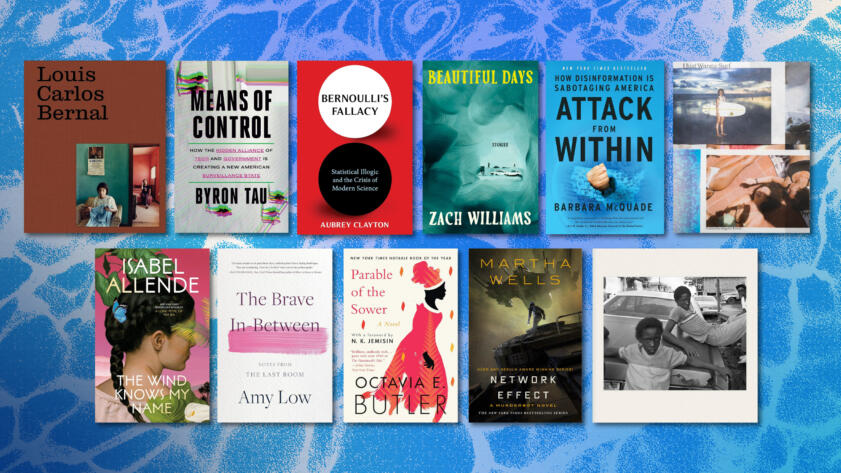Subscribe to Hello World
Hello World is a weekly newsletter—delivered every Saturday morning—that goes deep into our original reporting and the questions we put to big thinkers in the field. Browse the archive here.
Hey y’all,
We’re officially in the dog days of summer, which also means it’s the best time to start making a dent in that TBR (to be read) pile. Or maybe that New Year’s Resolution to read more than you did last year is haunting you—the call is coming from inside the house here. Our team, (which, if you haven’t heard, we merged with CalMatters), put together some recommendations for your next pool day, beachside vacation, or, if you’re like me, for the next time you’re curled up on the couch directly under the ceiling fan riding out a heat wave.
Subscribe to Hello World
Hello World is a weekly newsletter—delivered every Saturday morning—that goes deep into our original reporting and the questions we put to big thinkers in the field. Browse the archive here.
The Wind Knows My Name
by Isabelle Allende
Set against the backdrop of Nazi-occupied Vienna in 1938, this fictional story follows the journey of Samuel Adler, a 5-year-old boy. After his father disappears during the purge of Kristallnacht, Samuel’s mother is desperate to save her son’s life, so she sends him alone on the Kindertransport train to England. Samuel survives, but he never sees his birth family again.
“It’s a life-and-death choice that no parent should ever have to make. What happened to those displaced kids?” Isabel Allende writes in her Author’s Note about the play that sparked her curiosity about the Kindertransport. Allende began studying other instances of children throughout history who have been separated from their parents, such as Black children sold into slavery and Indigenous children taken from their families and placed in boarding schools.
After Samuel flees Vienna, Allende’s novel flashes forward to 2019. Now, 7-year-old Anita Díaz and her mother are also on a train, fleeing state-sanctioned violence in El Salvador and bound for the Arizona borderlands. They arrive just as the U.S. federal government is instituting a family separation policy, aimed at deterring asylum-seekers from coming to the U.S. border. Anita is torn from her mother and then alone in a camp in Nogales. She has no one to talk to but her imaginary friend, Claudia, and Selena Durán, a social worker who tries to find Anita’s mother and help the child with her asylum case.
Durán’s character is loosely based on real-life humanitarian aid workers with the Florence Refugee and Immigrant Rights Project, according to the book’s acknowledgments. From California to Texas, the border has many people like her, working each day to provide food, shelter, comfort, and information to migrants.
If you know Allende, you know there’s almost always at least one character who is clairvoyant, and in this book, it’s Selena’s grandmother, but it’s also the reader who realizes well before the plot makes it obvious how history can repeat itself. – Wendy Fry, Reporter, CalMatters
Attack From Within
By Barb McQuade
At CalMatters’ inaugural Ideas Fest in June, our CEO Neil Chase moderated a discussion about disinformation with former U.S. Attorney Barbara McQuade, who is also the author of Attack From Within: How Disinformation is Sabotaging America. The book, published in February, explores the history of disinformation, common tactics for its spread and possible solutions. At the festival, McQuade said that she hopes her book inspires a national dialogue about truth — and its importance to democracy — within a polarized political landscape. –Ko Bragg
Means of Control: How the Hidden Alliance of Tech and Government Is Creating a New American Surveillance State
By Byron Tau
Byron Tau broke some of the biggest stories about the massive ecosystem of shadowy data brokers collecting our personal data from our mobile phones, including our precise movements. Tau tells the fascinating story of this industry’s origin and how it fueled government surveillance, bypassing constitutional protections. – Jon Keegan, Reporter, CalMatters
Bernoulli's Fallacy: Statistical Illogic and the Crisis of Modern Science
by Aubrey Clayton
With Bernoulli’s Fallacy, mathematician Aubrey Clayton has done, if not the impossible, at least the improbable: Written an urgent, fire-breathing polemic about statistics. Clayton places the blame for the replication crisis currently roiling academia, where a terrifyingly large number of experimental results don’t reappear after running the same experiment again, squarely at the feet of the eugenicists who came up with many widely used statistical methods. Basically, Clayton argues, a bunch of racists wanted to use math to prove their flimsy points, but ended up infecting entire disciplines with techniques that don’t actually prove what they’re supposed to. A fundamental reframing of how we think about probability, Clayton insists, is the only way to save science from collapsing in on itself. –Aaron Sankin, Reporter, CalMatters
Beautiful Days
by Zach Williams
These short stories by Zach Williams, a writer from San Francisco, are perfect if you’re in the mood for literary fabulist tales—stories featuring the odd or the uncanny. The title is taken from the last line of his story, “Wood Sorrell House,” published in The New Yorker in 2022. This story is about a couple who find themselves trapped in a short-term rental vacation home. Williams was a Stegner Fellow at Stanford University and follows in the tradition set by fellow Stegner alumna Kate Folk, also a San Francisco resident, whose collection of speculative short stories “Out There” was critically well received two years ago. – Alejandro Lazo, Climate Reporter, CalMatters
The Brave In-Between: Notes from the Last Room
by Amy Low
If you’re in the Bay Area you may know Amy Low, the longtime managing director for nonprofit media at Emerson Collective. In this book she opens a window into her life with Stage IV colon cancer, through heartbreak and uncertainty. It’s a profound and vulnerable look into what ultimately matters most to her: love and motherhood. – Dan Hu, Strategic Partnerships Consultant, CalMatters
Parable of the Sower
By Octavia Butler
Octavia Butler knew 2024 would be a transformative year. Written 31 years ago, Butler’s novel “Parable of the Sower” is set in a post-apocalyptic world ravaged by climate change and social unrest. It follows protagonist Lauren Olamina, an 18-year-old who can feel other people’s pain, as she tries to navigate her new reality and her place in it. No other book has made me more fearful but hopeful at the same time about the growing change in our society. Butler’s vivid storytelling had me glued to every page and her words “God is Change” will stay with me forever. This book is not your average science fiction novel. It is gospel and a mirror to a very alarming reality. – Adriana Heldiz, Assistant Visual Editor, CalMatters
Three photo book recommendations from Miguel Gutierrez Jr, CalMatters’ Visuals Editor
- Louis Carlos Bernal's "Monografía" is a photo book I wish I would've been exposed to when I was younger because I wonder how it would've shaped the trajectory of my photography. I also wonder how it would've shaped my perception of "self" as a Chicano. Bernal's photographs of barrio communities in the southwest are extremely intimate and personal. They remind me of my tías, abuelos, primas and our homes. Bernal highlights the beauty of "la vida cotidiana," but also the beauty of being Mexican-American.
- I first learned of Baldwin Lee's photographs while visiting the George Eastman Museum in Rochester, New York, in June of this year. Relegated mostly to obscurity, Lee's work gained notoriety in 2022. Lee is a first generation Chinese-American photographer who extensively photographed Black communities in the South between 1983 and 1989, while teaching at the University of Tennessee. Rather than emphasizing poverty or reinforcing stereotypes, Lee photographed beauty, intimacy, and pride. His namesake book Baldwin Lee debuted in 2022.
- In a sport typically dominated by white men, Gabriella Angotti-Jones documents in “I Just Wanna Surf” a vibrant community of Black women and non-binary surfers in Southern California. Growing up in one of the few mixed-race Black families in her community in Orange County, Angotti-Jones reflects on her love of the ocean, surfing, and her identity as a Black woman. This book feels light and care-free, much like the surfing lifestyle images of the 1980s, but instead of sun-kissed blondes, we're presented with sun-kissed Black surfers who bond through their love of the beach, community and friendship. This is a beautiful book that feels partly like a zine, photo book, and personal diary. Angotti-Jones did a beautiful job of creating an ode to friendship and Black joy.
The Murderbot Diaries
by Martha Wells
I find the titular narrator of Martha Wells’ Hugo Award-winning series of novels and novellas entirely too relatable: Murderbot, a private security cyborg, hacks itself and ends up with free will—that it prefers to exercise by shutting down and watching an endless stream of entertainment. After a contract goes awry, Murderbot ends up in the company of caring, ethical humans with whom it begins to develop close (and, therefore, inconvenient) relationships.
Over the course of the series, Murderbot uncovers political espionage, aids corporate separatists, and rescues its human and bot friends, all while wrestling with self-determination and social anxiety. Sure, Wells delivers a sharp rebuke of hyper-capitalism and corporatized societies. But, mostly, it’s a cozy, hilarious, and escapist read for turbulent times. —Soo Oh, Deputy Managing Editor, CalMatters
Happy reading!
Ko Bragg, Deputy Investigative Editor, CalMatters




